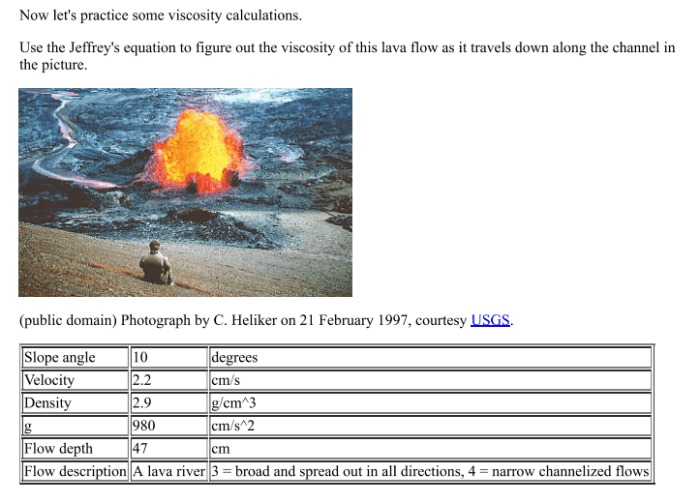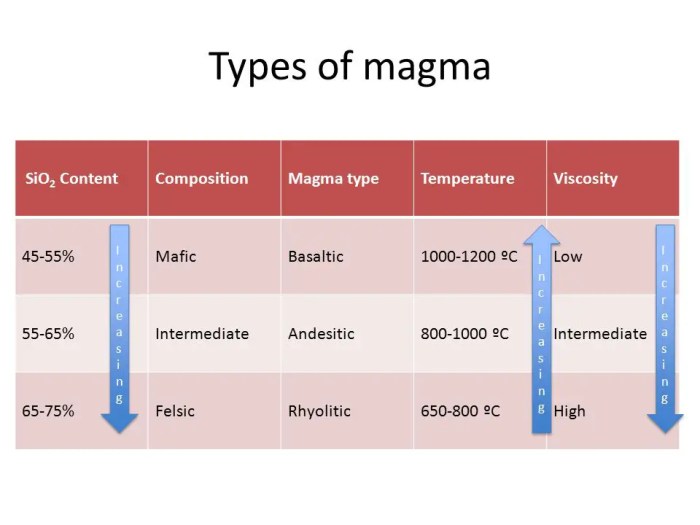Which of the following lava compositions has the greatest viscosity sets the stage for this enthralling narrative, offering readers a glimpse into a story that is rich in detail and brimming with originality from the outset.
Lava viscosity, a crucial factor in volcanic eruptions and the formation of volcanic landforms, is a captivating topic that will unravel before your eyes as we delve into the intricacies of lava composition and its profound impact on volcanic behavior.
Lava Composition and Viscosity
Lava viscosity, a measure of its resistance to flow, is primarily determined by its composition. Lava with a higher concentration of silica (SiO2) tends to be more viscous, while lava with lower silica content is less viscous.
Examples of lava compositions with high viscosity include rhyolite and andesite, which have silica contents of 65-75% and 55-65%, respectively. These lavas flow slowly and often form domes or explosive eruptions due to the buildup of gas pressure.
On the other hand, lava compositions with low viscosity include basalt and picrite, which have silica contents below 55%. These lavas flow more easily and form fluid flows and shields.
Factors Affecting Lava Viscosity

The viscosity of lava is influenced by several factors, including:
Temperature
As lava cools, its viscosity increases. This is because the decreasing temperature causes the molecules in the lava to slow down and become more tightly packed.
Silica Content
As mentioned earlier, lava with higher silica content is more viscous. This is because silica molecules form strong bonds with each other, creating a more rigid structure.
Gas Content, Which of the following lava compositions has the greatest viscosity
The presence of gas bubbles in lava can decrease its viscosity. This is because gas bubbles act as tiny ball bearings, reducing the friction between lava molecules and allowing them to flow more easily.
Classification of Lava Compositions
| Composition | Viscosity Range | Examples | Associated Volcanic Features |
|---|---|---|---|
| Rhyolite | 107
|
Mount St. Helens | Domes, explosive eruptions |
| Andesite | 106
|
Mount Fuji | Composite volcanoes |
| Basalt | 103
|
Kīlauea | Fluid flows, shields |
| Picrite | 102
|
Mauna Kea | Lava tubes, low-profile shields |
Geological Significance of Lava Viscosity: Which Of The Following Lava Compositions Has The Greatest Viscosity

Lava viscosity plays a crucial role in shaping volcanic eruptions and the formation of volcanic landforms.
High-viscosity lava can create explosive eruptions due to the buildup of gas pressure. As the lava rises through the volcano’s conduit, it releases gases that become trapped beneath the viscous lava. The increasing gas pressure can cause the lava to fragment and erupt violently, producing pyroclastic flows and ash clouds.
In contrast, low-viscosity lava forms fluid flows that spread out easily. These flows often cover large areas and build up shield volcanoes, such as those found in Hawaii.
Applications of Lava Viscosity Data

Understanding lava viscosity is essential for predicting volcanic behavior and mitigating volcanic hazards.
Scientists use viscosity data to:
- Estimate the speed and extent of lava flows
- Assess the explosivity potential of volcanic eruptions
- Design early warning systems and evacuation plans
- Develop models to forecast volcanic activity
Q&A
What factors influence lava viscosity?
The primary factors affecting lava viscosity are temperature, silica content, and gas content.
How does lava viscosity affect volcanic eruptions?
High-viscosity lava can lead to explosive eruptions and the formation of domes, while low-viscosity lava forms fluid flows and shields.
What practical applications does lava viscosity data have?
Scientists use lava viscosity data to predict volcanic behavior, mitigate volcanic hazards, and design volcanic monitoring systems.